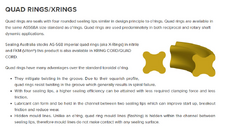JP_SCUBA
Registered
Hey there ... My question is fairly straight forward and that is, Why doesn't anyone use a Quad type O-ring for a piston seal? Has anyone here ever tried one? and if so then how did it function in comparison to a std. O-ring. I would think it would be an improvement in dependability as the Quad ring has actually 4 sealing surfaces instead of only two. I'm not talking about just a square piece of Buna rubber like a some of the Hydraulic/Pneumatic cylinder piston seal rings. (please see attached picture). This type of seal actually allows the fluid medium to get between the o-ring groove wall and seal and provide additional force to assist the quad ring in sealing. I'm going to be experimenting with an old MK10 clone regulator and see what results. Any input on this would be appreciated. The ring in the picture is not the size I'm replacing. I just used one a lot larger for a visual. The size I'm trying is a -017 for the piston on the MK10 clone..... Thanks in advance






